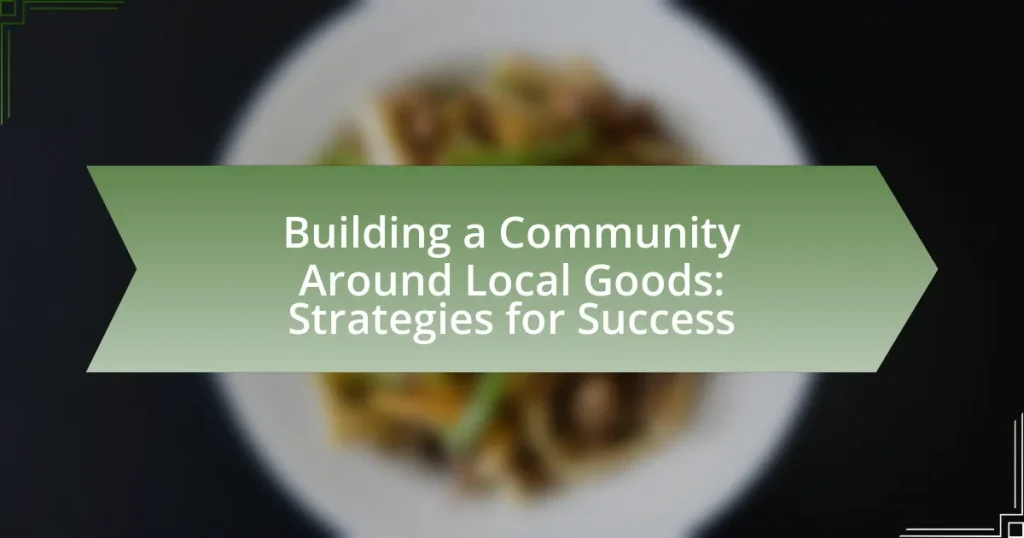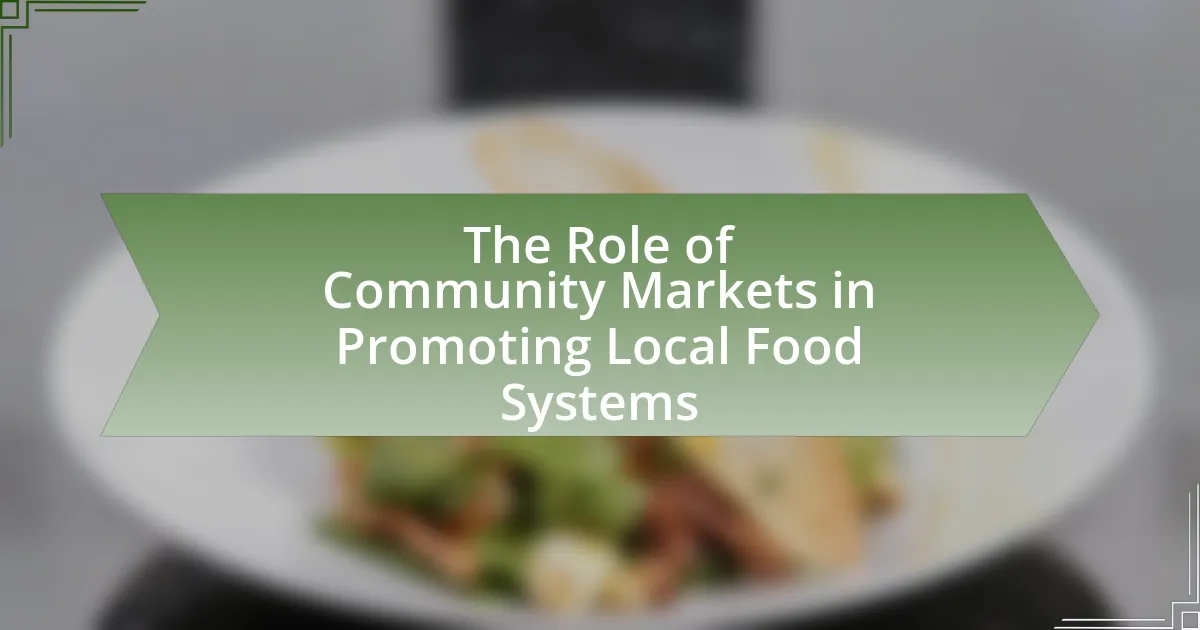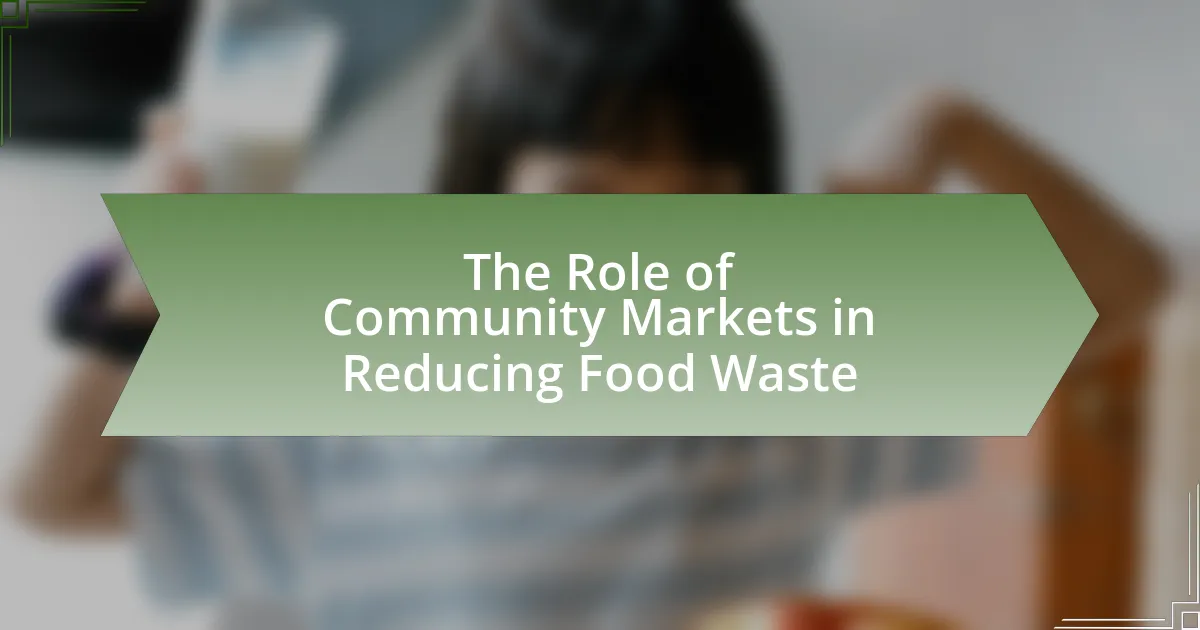Building a community around local goods involves creating connections among individuals and businesses that prioritize locally sourced products, fostering economic resilience and social ties. The article explores how local goods enhance community engagement, contribute to a sense of belonging, and support sustainability. It outlines key characteristics that attract community interest, strategies for successful community building, and the economic benefits of local goods. Additionally, it addresses challenges faced in promoting local goods and offers practical tips for maintaining community interest and participation.
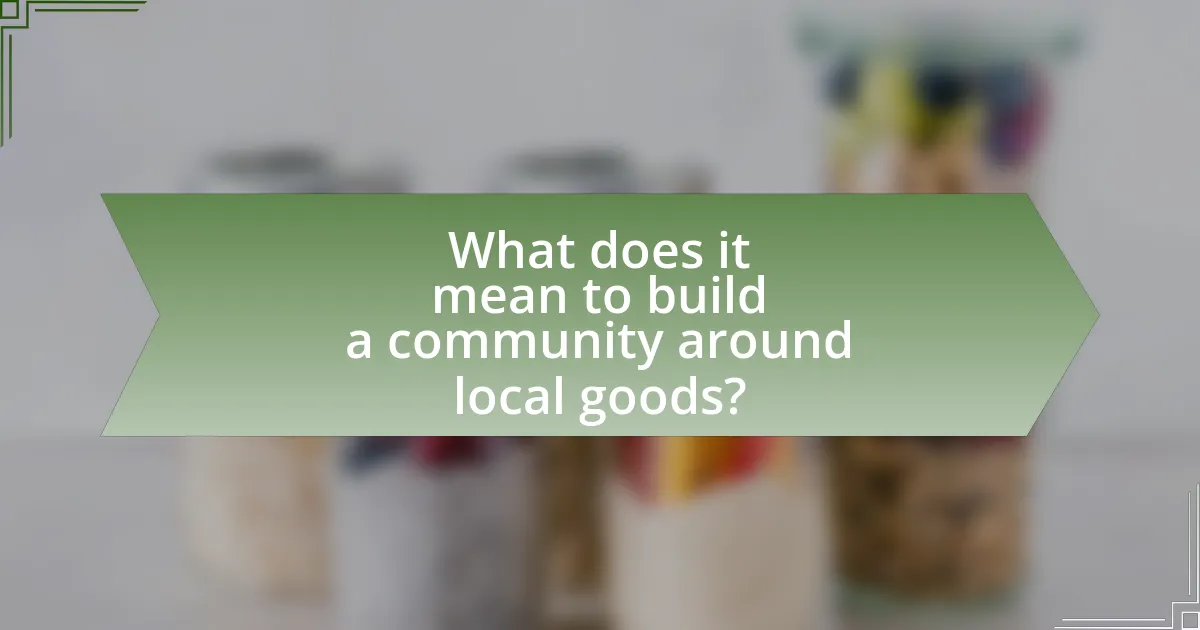
What does it mean to build a community around local goods?
Building a community around local goods means fostering connections among individuals and businesses that prioritize the production, distribution, and consumption of products sourced from the local area. This approach encourages collaboration, supports local economies, and enhances social ties by promoting shared values and interests related to sustainability and community well-being. Research indicates that communities engaged in local goods initiatives often experience increased economic resilience, as local spending circulates within the community, leading to job creation and enhanced local services.
How can local goods foster community engagement?
Local goods foster community engagement by creating a sense of belonging and supporting local economies. When community members purchase local products, they contribute to the financial stability of their neighbors, which strengthens social ties and encourages collaboration. Research indicates that communities with strong local goods movements experience increased participation in local events and initiatives, as individuals feel more connected to their surroundings and invested in their community’s success. For example, a study by the American Independent Business Alliance found that local businesses generate 70% more local economic activity per square foot than chain stores, highlighting the impact of local goods on community vitality and engagement.
What are the key characteristics of local goods that attract community interest?
Local goods attract community interest primarily due to their uniqueness, quality, and connection to local culture. These products often reflect the distinct characteristics of the area, such as traditional craftsmanship or locally sourced materials, which resonate with community values. For instance, a study by the American Independent Business Alliance found that local goods contribute to a sense of place and identity, fostering pride among residents. Additionally, local goods typically support the local economy, as purchasing them helps sustain local businesses and jobs, further enhancing community engagement and loyalty.
How do local goods contribute to a sense of belonging among community members?
Local goods foster a sense of belonging among community members by creating shared experiences and supporting local economies. When individuals purchase and consume products made within their community, they engage in a collective identity that strengthens social ties. Research indicates that communities with strong local goods markets experience increased social cohesion, as these markets serve as gathering places where residents interact and build relationships. For example, a study by the American Journal of Community Psychology found that local food initiatives not only boost local economies but also enhance community engagement and trust among residents. This connection to local goods reinforces a shared identity and pride, ultimately contributing to a deeper sense of belonging.
Why is building a community around local goods important?
Building a community around local goods is important because it fosters economic resilience and strengthens social ties. Local goods support regional economies by keeping money within the community, which can lead to job creation and sustainable development. According to a study by the American Independent Business Alliance, local businesses recirculate approximately three times more money in the local economy compared to chain stores. This economic impact enhances community identity and encourages collaboration among residents, ultimately leading to a more vibrant and interconnected society.
What economic benefits does a local goods community provide?
A local goods community provides significant economic benefits by fostering local entrepreneurship and keeping money circulating within the community. This circulation enhances local job creation, as businesses often hire locally, which reduces unemployment rates. According to a study by the American Independent Business Alliance, local businesses recirculate approximately 3.5 times more money in the local economy compared to chain stores. Additionally, local goods communities can lead to increased property values, as vibrant local businesses attract more residents and visitors. This economic model not only supports local producers but also strengthens community ties, creating a more resilient local economy.
How does a community around local goods support sustainability?
A community around local goods supports sustainability by reducing transportation emissions and promoting local economies. When consumers purchase locally produced items, they minimize the carbon footprint associated with long-distance shipping, which is a significant contributor to greenhouse gas emissions. Additionally, supporting local businesses keeps money within the community, fostering economic resilience and encouraging sustainable practices among producers. Research indicates that local food systems can reduce energy use by up to 50% compared to conventional food systems, highlighting the environmental benefits of local sourcing.

What strategies can be employed to successfully build a community around local goods?
To successfully build a community around local goods, strategies such as fostering local partnerships, organizing community events, and utilizing social media platforms are essential. Fostering local partnerships involves collaborating with local businesses, artisans, and farmers to create a network that supports and promotes local products. Organizing community events, such as farmers’ markets or craft fairs, encourages local engagement and provides a platform for local goods to be showcased. Utilizing social media platforms allows for effective communication and marketing, enabling community members to share their experiences and promote local goods to a wider audience. These strategies are supported by studies indicating that community engagement and local collaboration significantly enhance consumer loyalty and support for local economies.
How can local businesses collaborate to strengthen community ties?
Local businesses can collaborate to strengthen community ties by organizing joint events and promotions that engage residents and foster local pride. For instance, businesses can host community fairs or markets where they showcase local products, encouraging residents to support their neighbors. Research indicates that community events can increase local spending by up to 30%, as they create a sense of belonging and connection among residents. Additionally, partnerships between businesses for cross-promotions or shared marketing efforts can amplify their reach and impact, reinforcing community bonds.
What types of partnerships can enhance the visibility of local goods?
Collaborative partnerships between local businesses, community organizations, and marketing platforms can significantly enhance the visibility of local goods. For instance, local farmers can partner with restaurants to feature their produce on menus, thereby increasing awareness among consumers. Additionally, collaborations with local artisans and crafters can lead to joint marketing efforts, such as pop-up markets or community events, which showcase a variety of local products. Research indicates that community-supported agriculture (CSA) programs, which connect consumers directly with local farmers, have seen a 20% increase in participation over the last decade, demonstrating the effectiveness of such partnerships in promoting local goods.
How can joint marketing efforts benefit local businesses?
Joint marketing efforts can significantly benefit local businesses by increasing their visibility and reach within the community. When multiple businesses collaborate on marketing initiatives, they can pool resources, share customer bases, and create a stronger collective brand presence. For instance, a study by the Local Initiatives Support Corporation found that businesses participating in joint marketing campaigns experienced a 20% increase in foot traffic compared to those marketing independently. This collaborative approach not only enhances brand awareness but also fosters community engagement, as customers are more likely to support businesses that work together to promote local goods and services.
What role do events play in building a community around local goods?
Events play a crucial role in building a community around local goods by providing a platform for interaction between producers and consumers. These gatherings foster relationships, enhance visibility for local products, and create a sense of belonging among community members. For instance, farmers’ markets and craft fairs not only showcase local goods but also encourage direct engagement, allowing consumers to meet the makers and understand the story behind the products. Research indicates that communities with regular local events experience increased economic activity, as seen in a study by the American Planning Association, which found that local events can boost sales for small businesses by up to 30%. This interaction cultivates loyalty and support for local goods, reinforcing community ties and promoting sustainable practices.
How can community events promote local goods effectively?
Community events can effectively promote local goods by creating direct engagement opportunities between producers and consumers. These events, such as farmers’ markets or craft fairs, allow local businesses to showcase their products, fostering a sense of community and encouraging residents to support local economies. Research indicates that consumers are more likely to purchase from local vendors when they have the chance to interact with them, as personal connections enhance trust and loyalty. For instance, a study by the American Independent Business Alliance found that local businesses recirculate a greater share of every dollar as they create locally owned supply chains, which strengthens the local economy.
What types of events are most successful in attracting community participation?
Community festivals and farmers’ markets are the types of events most successful in attracting community participation. These events foster local engagement by providing a platform for residents to connect, support local businesses, and enjoy shared experiences. According to a study by the National Endowment for the Arts, community festivals can increase social cohesion and enhance community identity, leading to higher participation rates. Additionally, farmers’ markets have been shown to draw diverse demographics, with a report from the USDA indicating that they often attract over 1,000 visitors per market day, demonstrating their effectiveness in engaging the community.
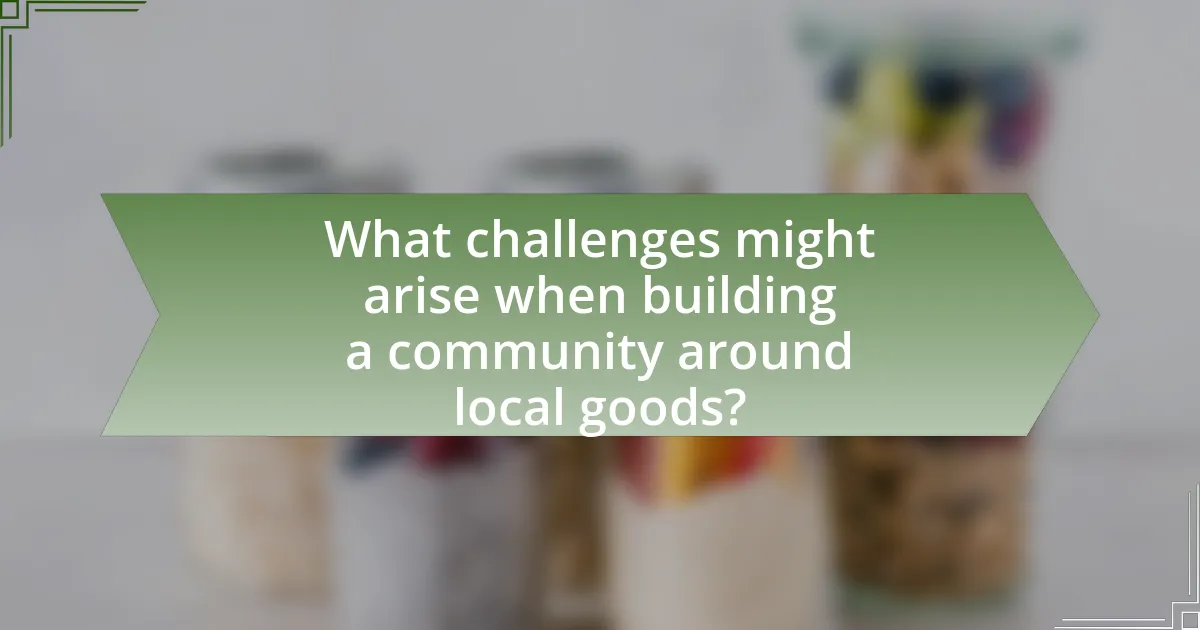
What challenges might arise when building a community around local goods?
Building a community around local goods can face several challenges, including limited consumer awareness, inconsistent supply chains, and competition from larger retailers. Limited consumer awareness can hinder community engagement, as potential customers may not recognize the value of supporting local businesses. Inconsistent supply chains can disrupt the availability of local goods, making it difficult for consumers to rely on them. Additionally, competition from larger retailers often offers lower prices and greater convenience, which can deter consumers from choosing local options. These challenges necessitate strategic efforts to educate consumers, strengthen supply networks, and differentiate local goods in the marketplace.
How can communities overcome resistance to supporting local goods?
Communities can overcome resistance to supporting local goods by implementing educational campaigns that highlight the economic and social benefits of local purchasing. These campaigns can inform residents about how buying local strengthens the local economy, creates jobs, and fosters community ties. For instance, studies show that local businesses recirculate a greater share of every dollar as they create locally owned supply chains and invest in their communities. Additionally, organizing events such as farmers’ markets or local fairs can provide direct exposure to local products, helping to build familiarity and trust among consumers. Research indicates that communities with strong local business networks experience increased consumer loyalty and engagement, further solidifying support for local goods.
What strategies can be used to educate the community about the benefits of local goods?
To educate the community about the benefits of local goods, strategies such as organizing workshops, creating informational campaigns, and collaborating with local businesses can be employed. Workshops can provide hands-on experiences that highlight the quality and uniqueness of local products, fostering a deeper appreciation among community members. Informational campaigns, utilizing social media and local media outlets, can disseminate facts about the economic and environmental advantages of supporting local goods, such as the reduction of carbon footprints and the support of local economies. Collaborating with local businesses can create events like farmers’ markets or local fairs, where community members can directly engage with producers, enhancing their understanding of the benefits of purchasing local goods. These strategies are effective as they create direct interactions and provide factual information that resonates with community values.
How can local goods compete with larger, non-local businesses?
Local goods can compete with larger, non-local businesses by emphasizing unique value propositions such as quality, community engagement, and personalized customer service. Local products often feature superior craftsmanship and locally sourced materials, which appeal to consumers seeking authenticity and sustainability. For instance, a study by the American Independent Business Alliance found that local businesses recirculate a greater share of every dollar as they create locally owned supply chains and invest in their employees. Additionally, local businesses can foster strong community ties through events, collaborations, and local marketing, which enhances customer loyalty and differentiates them from larger, impersonal corporations.
What are the common pitfalls to avoid in building a community around local goods?
Common pitfalls to avoid in building a community around local goods include neglecting to engage with the community, failing to understand local needs, and not providing consistent quality. Engaging with the community fosters trust and loyalty, while understanding local needs ensures that the goods offered resonate with consumers. Consistent quality is crucial, as it maintains the community’s interest and satisfaction. According to a study by the American Independent Business Alliance, communities that actively engage with local businesses see a 50% increase in local economic activity, highlighting the importance of these factors in successful community building.
How can miscommunication hinder community engagement?
Miscommunication can significantly hinder community engagement by creating misunderstandings and mistrust among community members. When information is not clearly conveyed, individuals may misinterpret intentions, leading to disengagement or conflict. For instance, a study by the International Association for Public Participation found that unclear messaging in community initiatives often results in lower participation rates, as residents feel uninformed or skeptical about the goals of the engagement efforts. This lack of clarity can prevent effective collaboration and diminish the sense of community, ultimately undermining the success of local goods initiatives.
What are the risks of not involving diverse community voices?
Not involving diverse community voices risks perpetuating inequities and limiting the effectiveness of community initiatives. When diverse perspectives are excluded, decision-making processes may overlook the unique needs and challenges faced by marginalized groups, leading to solutions that do not address the realities of the entire community. This exclusion can result in decreased community engagement, as individuals feel their voices are not valued, which ultimately undermines the sustainability of local goods initiatives. Research indicates that inclusive practices enhance innovation and problem-solving, as diverse teams are more likely to generate creative solutions (Page, S. E. 2007, “The Difference: How the Power of Diversity Creates Better Groups, Firms, Schools, and Societies”). Therefore, failing to involve diverse voices not only risks alienating segments of the community but also diminishes the overall effectiveness and impact of community-building efforts.
What practical tips can help in building a successful community around local goods?
To build a successful community around local goods, focus on fostering relationships among local producers, consumers, and stakeholders. Establish regular events such as farmers’ markets or craft fairs to create opportunities for interaction and engagement. Research indicates that communities with strong local networks see a 10-20% increase in local economic activity, as highlighted by the American Independent Business Alliance. Additionally, utilizing social media platforms to promote local goods and share stories about producers can enhance visibility and connection, leading to increased community support.
How can social media be leveraged to promote local goods and community events?
Social media can be leveraged to promote local goods and community events by creating targeted campaigns that engage local audiences. Businesses and event organizers can utilize platforms like Facebook, Instagram, and Twitter to share visually appealing content, such as images and videos of products or event highlights, which can increase visibility and attract local customers.
For instance, a study by the Pew Research Center indicates that 69% of adults in the U.S. use social media, making it an effective channel for reaching a broad audience. Additionally, using location-based hashtags and geotags can enhance discoverability among community members. Engaging with followers through interactive posts, contests, and live events can foster a sense of community and encourage word-of-mouth promotion, further amplifying reach and engagement.
What best practices should be followed to maintain community interest and participation?
To maintain community interest and participation, it is essential to foster open communication and create inclusive opportunities for engagement. Open communication ensures that community members feel heard and valued, which can be achieved through regular updates, feedback mechanisms, and transparent decision-making processes. Creating inclusive opportunities involves organizing events, workshops, and activities that cater to diverse interests and demographics, thereby encouraging broader participation. Research indicates that communities with high levels of engagement often see increased satisfaction and loyalty among members, as evidenced by studies showing that participatory initiatives can lead to a 30% increase in community involvement over time.
